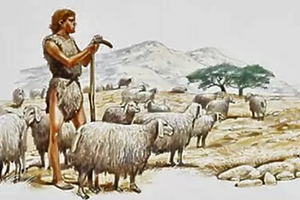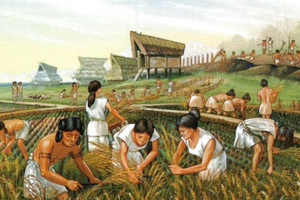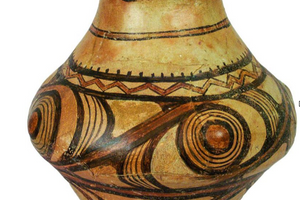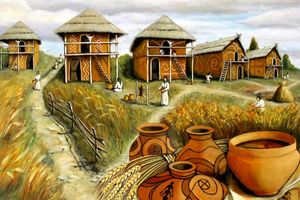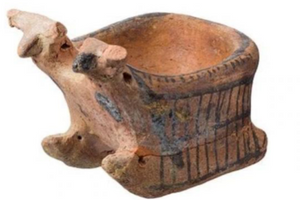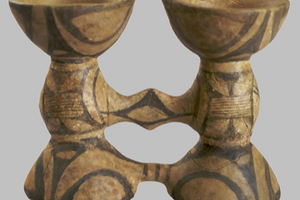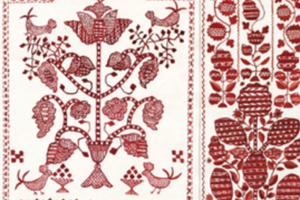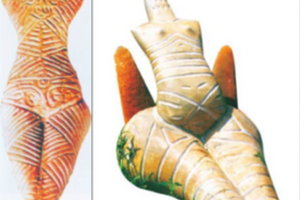The most common character of Trypillian plastic art was a maiden or a woman or a "madonna". Trypillians were characterized by matriarchy. Women rightfully occupied prominent places in the family, because they were given the highest power - the power to give life, to procreate. They were endowed with magical properties for their closeness to nature. Women-mothers were treated with great respect, so a significant number of statuettes were created in their honor, which carried a deep meaning.
 Trypillia "madonnas" are numerous small female ceramic figurines with voluminous bellies, hips, and small breasts. Most of the sculptures found have holes at the ends of their arms. This indicates that they were used as objects of worship. Apparently, they were hung from trees and rituals were performed outside.
Trypillia "madonnas" are numerous small female ceramic figurines with voluminous bellies, hips, and small breasts. Most of the sculptures found have holes at the ends of their arms. This indicates that they were used as objects of worship. Apparently, they were hung from trees and rituals were performed outside.
In Trypillian culture, there are many figures of women: they are depicted standing, sitting, pregnant, sometimes they are goddesses who were idols of certain cults: women with the heads of owls, cows, and two heads.
The figures were most often decorated with the symbols of a spiral and a sickle. They personified the cyclical nature of changes and the moon, the feminine element. The spiral was also depicted on the breasts of goddesses. This pointed to feeding as a sacrament of endowment with life force coming from a woman. A woman who gave birth to children was probably already ranked among the goddesses. And milk was considered a drink of strength, life, and fortification. The symbolism of the spiral also represented the rains, after which the earth bore fruit.
Of the signs found on female figures, the diamond with dots is particularly noteworthy, symbolizing, above all, the idea of female fertility. Variants of female terracotta with accentuated signs of pregnancy or figures with hands supporting their breasts (the Venus pose) only confirm the main focus. Grains were attached to the sides of the image, which may have been a ritual of attracting the harvest. In general, the image can be read as a sown field over which it is raining, which will certainly result in a rich harvest in the future. Trypillians also depicted oblique lines on the thighs of goddess figures, which represent heavy rains - receiving life-giving moisture from the heavens. According to some versions, Trypillian women put such patterns on their bodies - tattoos - to gain the favor of the heavens for their family.
There are also figures of Oranta with their arms raised in the air on Trypillian monuments. This prayerful gesture corresponds to the horns of a cow, symbolizing the sickle of the new moon. Thus, the Goddess Oranta, who appeals to the higher powers, has the features of a cow and a bird and is symbolically associated with the new moon. Thus, the first and most important place in the pantheon of Trypillian gods belonged to the Great Mother Goddess, the feminine principle of fertility, which reflected the idea of the reproductive functions of the Earth, women, and Nature.
The spiritual world of the Trypillia tribes, born out of the ideology of the agricultural cultures of the East, remains a very interesting element of history. As a consequence of the primitive beliefs that had been accumulating over the years in the community of that time, it began to spread to almost all spheres of human activity. One such example where primitive beliefs were reflected was the material culture of the Trypillian tribes. According to sources, the central figure of the pantheon was the image of a woman-mother, the Great Goddess of Fertility, the goddess of the earth who brought harvests. This image was embodied in various anthropomorphic statuettes, which are now called "Trypillian Venus". Such statuettes had a religious purpose, even the notches made on some of them, according to researchers, could have had various religious functions. Grain or flour was added to the clay, and it was believed that the grain left in the likeness of the goddess would yield a harvest. The monument of the culture of that time itself has disproportionate body shapes, namely widened hips, symbolizing fertility
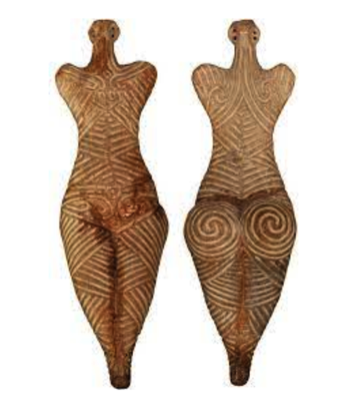
The Trypillian woman, a symbol of life and fertility, the Mother of all things, who gives life and protects from evil, came to us from the depths of millennia. From the mysterious Trypillian civilization, whose largest cities were built on the territory of the present-day Cherkasy region.
The Trypillian woman left her mark on the consciousness and cultural code of our people. The continuation of the traditions of respect for women are the famous so-called "straw dolls" that were woven either from branches of rye straw (the last sheaf of wheat after the harvest, from which the famous Didukh was made) or from holy herbs, either medicinal herbs collected at holy places or herbs collected for the holiday of Ivan Kupailo or other holidays. Madonnas were believed to be woven from the hair of Mother Earth. In the antithetical culture of the Ukrainian people, everything associated with the earth was considered sacred, consecrated, divine (previously, people confessed "into the earth," made contracts and swore before "Mother Earth raw" by sprinkling their hair with sod, etc.) Therefore, it is clear that the "praying Madonnas" were not children's toys. No one ever played with the "Madonnas," they were not even touched, as this would mean breaking the silence of prayer. And not just any prayer, but a mother's prayer.

The information was collected by the editor Svitlana Zabolotna
References:
1. https://m.gordonua.com/ukr/interesting/davni-simvoli-zagadka-tripilskih-madonn-1542685.html
2. http://www.philosophy.chnu.edu.ua/res/philosophy/2013-Konf.pdf#page=117
3. http://uman.info/ua/news/trypilski-zhinky-buly-vidmamy---734
4. https://www.radiosvoboda.org/a/trypilska-kultura-ukrayina/31078240.html
6. https://we.org.ua/history/davni-chasy/starodavnye-trypillya-tayemnytsi-ta-skarby/


























































